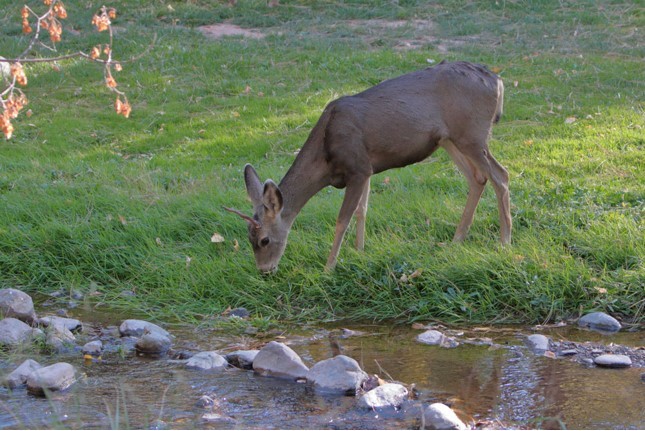
Ruidoso October
October 11 – 17, 2020
The most painful thing Covid-19 forced me to do this year was cancel two trips to Yellowstone. I hoped we would squeeze in a trip in September, but by that time air travel was still dicey. After a long, hot Texas summer with no swimming pools to cool us, we were ready to go somewhere. Anywhere. So, in this year without Yellowstone, there was Ruidoso, our escape from real life.
The drive to Ruidoso from Austin is about nine and one-half hours through the hill country and west Texas. The route runs through tiny towns, cotton fields and long stretches of dry land with cattle, oil rigs and, surprisingly, antelope.
We rented a comfortable cabin on the Rio Ruidoso with a wonderful long deck where we watched juncos, ruby throated kinglets, nuthatches, field sparrows, house finches, gold finches and acorn woodpeckers. Noisy ravens flew back and forth while mule deer drank from the river and grazed between the cabins. The deer were almost tame, willingly accepting apples from visitors’ hands. Unfortunately the river was too low for fishing and it was probably too warm. Mornings began in the 40s, rising quickly to the 80s; the sun shone every day, not a cloud in the sky, but, when the sun began to set, the temperature quickly dove.
The first day we drove to Cloudcroft, winding through forest on Apache reservation land to the Lincoln National Forest. Mobile homes with barns, corrals, and other ranch outbuildings peppered the hillsides while cattle and horses grazed in a valley covered with golden grass. The road rises steadily in elevation; the hillsides are covered with pine trees and aspen. Trees are changing color now and the aspen and cottonwoods are particularly beautiful, standing out like yellow flames on the hillsides.
We hiked every day. The first trail we followed, the Zinker Cayon Trail, is outside Cloudcroft in the national forest. The road leading to the trailhead is closed to vehicles, but makes a nice wide trail of dirt, grass and rocks and continues for one or two miles before reaching the trailhead. The hike itself is only one mile, climbing through tall pines, aspen and burr oak. We saw juncos, field sparrows, hawks and stellar’s jays. Wild horses roam this area as well as elk. We saw lots of tracks and even heard an elk bugle on our way down the trail.
The next evening we returned to the same area at dusk. A small herd of wild horses gathered alongside the road at a large puddle. Their manes were long and shaggy, their coats caked with dirt and dust; their long forelocks hung on each side of their faces. A foal stared at us from the center of the muddy water while a couple of mares and a stallion grazed at the puddle’s edge. Water is scarce here. We were parked just across the road and the horses took note, particularly the stallion who paced back and forth. Not wanting to distract them from drinking or draw them into the road, we drove on.
Down the road a herd of 15 cow elk foraged on a hillside below the woods. We stopped and rolled down the windows, listening for bugling, but all was quiet except for vehicles racing past. We heard an elk bugle as we first drove down the highway that evening, but all we saw were cattle and horses. On the way back, the elk call sounded again and there he was – grazing with two cows and a spring calf.
We spent mornings walking along the river and watching the birds from the deck before taking off to explore other trails. The water is so beautifully clear and I loved the way sunlight reflects off the river. We hiked Grindstone Canyon Trail and Mesa Loop, the Cedar Creek Trails, the Sierra Blanca Trail and Lower and Upper Jerryatrics, climbing steadily upward through ponderosa and pinyon pine and fading wildflowers to beautiful views of Ruidoso and the White Mountain Wilderness. Signage on the trails was not great and we wound up backtracking more than once, but the trails themselves were well maintained.
I find myself comparing the landscape of Ruidoso with the high desert of Yellowstone. The mountains look much the same as those surrounding Gardiner and Mammoth Hot Springs. The autumn colors are vibrant – red mixed with the aspen’s fiery gold and the deep green of cedar and pine, forming a mélange that is extraordinarily beautiful.
Our last afternoon three mule deer does came to drink and graze along the river. One large doe stepped across the river toward the deck where I sat with my hand outstretched holding an apple. The other two does ignored me, but she walked straight over. Hesitating, she knew exactly what that apple was and slowly approached. When she was about one yard away, I placed the apple in the grass about 10-12 inches away. She looked at me the whole time as she moved forward and took the apple. I have never been that close to a deer before. Her brown eyes were huge, her black nose sniffing, trying to gauge my scent. Her small hooves delicate looking, shining with river water. She stared at me, waiting, I squatted down, my hand outstretched once again and she walked over to me. First I put my hand on the ground, apple slice in my palm. She picked it up in her mouth. The next pieces she ate out of my hand, her eyes on me the entire time. When the apple was gone, she just stared at me. She didn’t run away, or run after me, or walk toward me. She just went back to grazing with the other does.
– Christine Baleshta



